#spruce knob-seneca rocks national recreation area
Text

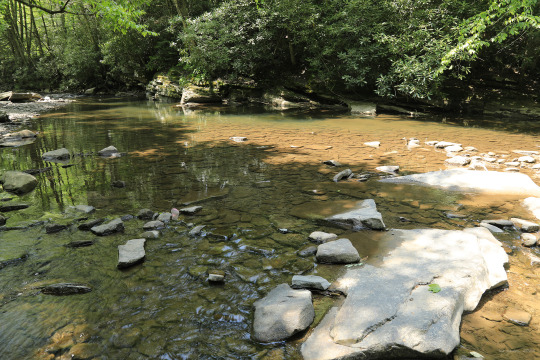
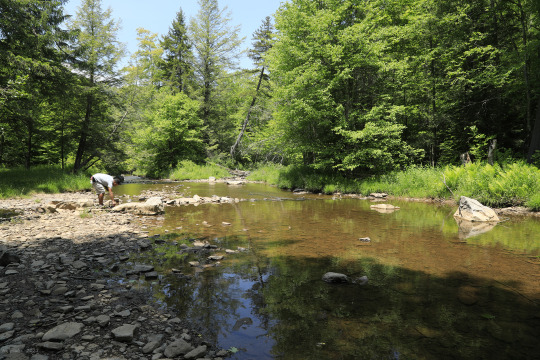
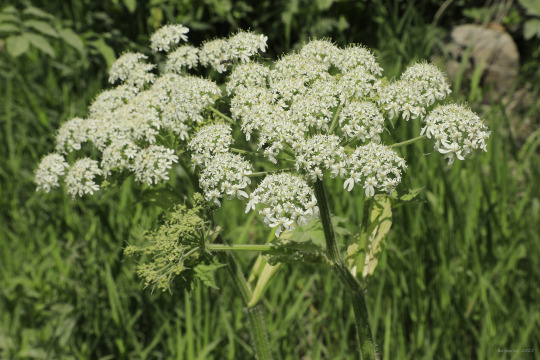




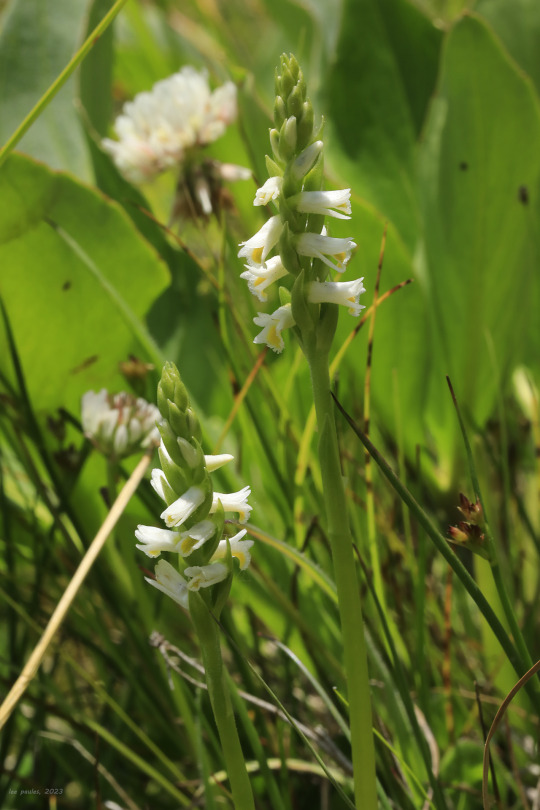
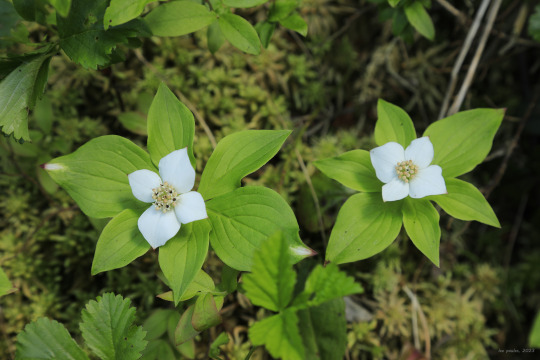

Day Date at Spruce Knob-Seneca Rocks National Recreation Area, Part 1. Most couples would probably equate a "date" to a nice dinner out and a Marvel adventure movie, but Blake and I, being hopeless nature fanatics and aspiring satyrs without hooves, equate it to mean "putzing around in the mountains". The timing was perfect: the haze from the Canadian wildfires, which has been choking most the US Mid-Atlantic and Northeast for the past week, had mostly moved on, replaced by a crisp blue sky with a light breeze.
From top: the view from the Rich Mountain Overlook on Old Route 33, heading toward Harman; Blake communing with the mystic creek chubs in Gandy Creek, one of the best brook trout streams in the Mid-Atlantic region; cow parsnip (Heracleum maximum), a mildly phototoxic beauty that Native Americans relied on for food and medicine; a forest composition of false green hellebore (Veratrum viride), ferns, wild geranium (Geranium maculatum), and golden Alexander (Zizia aurea); a close-up of golden Alexander, a lovely, spring-blooming member of the carrot family; the wetlands complex at Spruce Knob Lake; shining ladies' tresses (Spiranthes lucida), a spring to early summer-blooming bog orchid recognizable from its bright yellow labellum; bunchberry (Cornus canadensis), which can be easily mistaken for a spring-blooming forb but is actually a dwarf dogwood; and a feisty eastern garter snake (Thamnophis sirtalis sirtalis), whose saliva contains a mild neurotoxin that is deadly to its prey but harmless to humans.
#appalachia#vandalia#west virginia#wildflowers#spring#flora#allegheny mountains#monongahela national forest#spruce mountain#spruce knob lake#gandy creek#spruce knob-seneca rocks national recreation area#reptile#snake#eastern garter snake#cow parsnip#false green hellebore#wild geranium#golden alexanders#golden zizia#golden alexander#shining ladies' tresses#bunchberry#creeping dogwood#canadian dwarf cornel
132 notes
·
View notes
Photo

Warts and All (at Spruce Knob-Seneca Rocks National Recreation Area) https://www.instagram.com/p/CQ3UqU5tH-G/?utm_medium=tumblr
0 notes
Link
With some of the east coast's most beautiful and rugged scenery, West Virginia is filled with year-round outdoor adventure opportunities.
Its wild mountain country, densely-forested wilderness areas, and fast-running rivers are playgrounds for hiking, camping, caving, rock climbing, whitewater rafting, boating, and fishing. In the winter, ski resorts offer a range of snow sports. Active travelers will never run out of things to do here. While many tourists come to the state for these outdoor activities and scenic landscapes, West Virginia offers much more in the way of tourist attractions, from the historic sights of Harpers Ferry and the elegant Greenbrier and its legendary golf courses to some very unusual attractions, including a penitentiary to tour.
[toc]
1. Harpers Ferry
The Shenandoah River meets the Potomac River at this small West Virginia town, which was the site of abolitionist John Brown's raid on the United States arsenal in 1859, an event that hastened the onset of the Civil War.
Harpers Ferry National Historical Park has museums, historical exhibits, and programs, plus about 20 miles of hiking trails. You can explore the rocks where the rivers meet and walk up to St. Peter's Roman Catholic Church and the old cemetery on the hill behind it.
Also in Harpers Ferry is the Appalachian Trail Visitors Center, from which you can take a hike on the Appalachian Trail for views of the town and rivers. Local outfitters offer tubing excursions in the river.
2. New River Gorge National River
Contrary to its name, New River is one of the oldest rivers on the continent. When it flows into West Virginia, it cuts through the Appalachian Plateau, forming the New River Gorge and plenty of white water for pipes, rafting, and boating.
Other recreational opportunities revolve around it: hiking, walking, hunting, fishing, bird watching, camping, biking, and climbing. The most photographed attraction is the soaring New River Bridge, the longest steel span in the hemisphere and the nation's third tallest, 876 feet above the canyon floor.
The National Park Service maintains 70,000 acres of parklands along the river, and at Hawk's Nest State Park, you can ride an aerial tramway into the bottom of the New River Gorge, a prime spot for whitewater rafting.
South of New River Gorge National Park at Bluestone State Park there is hiking, fishing, camping and boating on the large lake behind the Bluestone dam.
3. Blackwater Falls State Park
Named for the dark waters of the Blackwater River, colored by tannic acid from fallen hemlock and red spruce needles, Blackwater Falls drops 60 feet over sandstone ledges before the river continues to rush through an eight-mile-long gorge. The steps and viewing platforms make the falls accessible year-round.
Besides, the famous places to visit in the park are Elakala Falls, which cascades down the canyon wall and can be reached by a short trail and Pendleton Falls, easily visible from a small path.
The view into the Blackwater Canyon from Lindy Point, one of the most beautiful places in West Virginia, is another park highlight, as is Pendleton Point Overlook, at the canyon's deepest point. The park has a boating lake, as well as swimming, fishing, and camping.
Address: 1584 Blackwater Lodge Road, Davis, West Virginia.
4. Whitewater Rafting
It's no secret that West Virginia is one of the best places to go whitewater rafting. Several rivers offer world-class rapids for experts, and others are well-suited to less experienced and learning rafters.
The most famous waters are in the Gauley River, between Summersville and Fayetteville, in the Gauley River National Recreation Area. Here, the 25-mile river flows at high speed through gorges and valleys, providing the thrill of a lifetime to experienced rafters; it's no wonder the Class V rapids are nicknamed the "Beast of the East."
Fall is the time to find the most challenging flow, but at any time it's a good idea to hire an experienced guide who knows the river and its quirks and can help you find the places that are best suited to your experience level. Although it's known for its Class V rapids the Gauley has some stretches of Class III that are suitable for intermediate levels.
For those with less experience, the Tygart River, Cheat River, and Potomac River are good options, as is the Upper New River, which has good stretches for beginners. Lower New River has Class IV rapids that offer runs past the New River Gorge Bridge.
5. Seneca Rocks and Monongahela National Forest
[caption id="attachment_703366" align="aligncenter" width="1024"] [/caption]
With elevations from about 1,000 feet to 4,863 feet above sea level, Monongahela National Forest offers the best views, wildlife and highest point in the state.
The variety of terrain and rainfall across its more than 900,000 acres gives it one of the most diverse forest ecosystems in the country, supporting more than 225 bird species; 75 species of trees; and 70 fish species, both game, and non-game.
About 100,000 acres of the park is designated as the Spruce Knob-Seneca Rocks National Recreation Area, offering some of the best traditional multi-pitch technical climbing on the east coast.
Seneca Rocks is a distinctive 250-foot-deep formation of white and gray quartzite that stands almost 900 feet above the North Fork River. Some routes are moderate, but experts are challenged by the exposed summit pinnacle.
Non-climbers can enjoy the Seneca Rocks Discovery Center and campgrounds at Seneca Shadows and Big Bend, along with thousands of acres of wildlands.
6. Snowshoe
This year-round resort is best known for its skiing, with three separate areas to choose from, all with 100 percent snowmaking. With an 800-foot vertical drop, Snowshoe Basin's 38 trails cover all experience levels, served by seven lifts, including a high-speed detachable quad.
Of Silver Creek's 18 trails, 12 are open for night skiing. The Western Territory Area's steep, rugged terrain has 1,500 feet of vertical drop, the most advanced terrain in the region. Steeps on Cupp Run, designed by legendary Olympian Jean-Claude Killy, and Shay's Revenge reach 52 percent pitch.
In other seasons, activities include mountain biking, scenic chairlift rides, geocaching, horseback riding, Segway tours, ziplining, trampolining, climbing, pedal boats, paddle boarding, canoeing, hiking, fishing, and golf at the Raven Golf Club. Not far away, in Greenbank, is the National Radio Astronomy Observatory.
Address: 10 Snowshoe Drive, Snowshoe, West Virginia
7. The Greenbrier
The Greenbrier has earned its designation as a National Historic Landmark several times over. Located at White Sulphur Springs, which has been in use as a natural spa since the 1700s, the grand hotel has hosted 26 presidents, foreign dignitaries, and royalty, including Prince Rainier and Princess Grace of Monaco and the Duke and Duchess of Windsor.
But however grand and luxurious it is as a resort, it has played other historic roles, too. Early in World War II, it was used as a detention center for German and Japanese diplomats who were in the United States when war was declared.
Later in the war, it was commandeered by the U.S. Army to use as a hospital, where nearly 25,000 patients were treated. During the Cold War, an underground shelter was built to house the entire U.S. Congress in case of a nuclear attack.
This shelter, given the code name "Project Greek Island," was decommissioned in 1992 and is open to the public for tours, as is the Presidents' Cottage Museum, with exhibits about presidential visits and the history of the resort.
More than 50 different activities are available in the resort and the 5,100-acre Greenbrier State Forest. Along with horseback riding, indoor and outdoor tennis courts, adventure courses, and a 40,000 square-foot spa, the resort has multiple golf courses (even an indoor one for winter) and an outstanding golf history is a venue for many championships.
Greenbrier State Forest offers cabins and campsites, swimming, fishing, bike trails, and hiking — the 78-mile-long Greenbrier River Trail is a multi-purpose rail-trail that is also used for cross-country skiing in the winter. A getaway in one of the centuries-old Legacy Cottages is one of the most romantic things to do in West Virginia.
Address: 300 W. Main Street, White Sulphur Springs, West Virginia
8. Seneca Caverns
The formation of the Seneca Caverns dates back to 460 million years before the cave's limestone beds first formed. The native Seneca are believed to have used caves for shelter starting in the early 1400s.
The cave was later found by a local farmer, Laven Teter while looking for water for his cattle. , and the largest chamber, up to 60 feet tall, was named Teter Hall in his memory.
You can visit one-hour guided tours down to 165 feet below the entrance. The walkways are well lit, and cement steps with handrails help visitors navigate deeper into caves. The separate Stratosphere Cave is on the same property.
Address: 3328 Germany Valley Road, Riverton, West Virginia.
9. West Virginia Penitentiary
One of the most unlikely places to visit in any state, the West Virginia Penitentiary welcomes guests from April through November to tour the grim prison that sometimes held more than 1,000 prisoners at a time.
The Gothic fortress was banned from opening in 1876 and the last prisoner left in 1995. Between those dates, it was the scene of fires, escapes, prison riots, and almost 100 executions.
Visitors can tour the building and its claustrophobia-inducing five-foot by seven-foot cells during the day, or explore the reportedly haunted location at night. A penitentiary is a popular place for paranormal researchers looking for evidence of spectral phenomena.
Address: 818 Jefferson Ave, Moundsville, West Virginia
10. Trans-Allegheny Lunatic Asylum
A unique tourist attraction like the West Virginia Court, Trans-Allegheny Lunatic Asylum is a landmark in the history of treatment for people with mental illness. Built between 1858 and 1881, the refugee is the largest hand-cut stone building in the hemisphere, and in the world, it is only exceeded by the Kremlin in Moscow.
Architect Richard Andrew designed this landmark. He arranged long rambling wings in a staggered formation so that each connected structure received as much therapeutic sunlight and fresh air. possible.
Tours highlight a number of historical themes, including architecture, Civil War raids, treatment of the mentally ill, even the facility's agricultural history and place in the local community. Like the West Virginia Court, the refugee camp is also a research site for paranormal investigators.
More ideals for you: Top 10 things to do in Rochester NY
From : https://wikitopx.com/travel/top-10-things-to-do-in-west-virginia-2-703358.html
0 notes
Photo

I had a good day ❤️ (at Spruce Knob-Seneca Rocks National Recreation Area)
0 notes
Photo

#seneca #senecarocks #senecarockswv #funactivecouple #climbing #tradclimbing #climblikeagirl #hikeclimbcamp (at Spruce Knob-Seneca Rocks National Recreation Area)
#funactivecouple#climblikeagirl#seneca#senecarockswv#climbing#tradclimbing#hikeclimbcamp#senecarocks
0 notes
Text

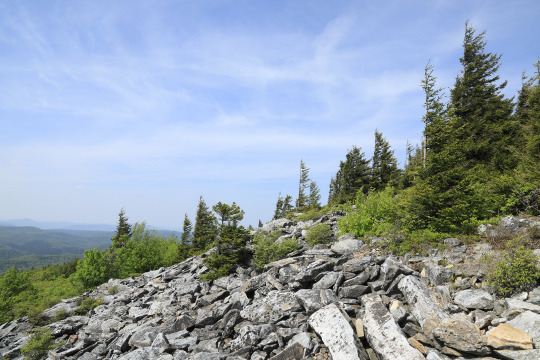
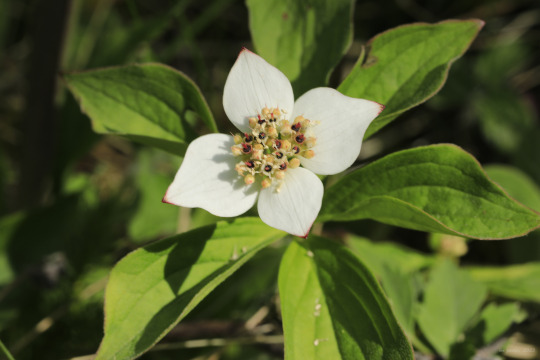
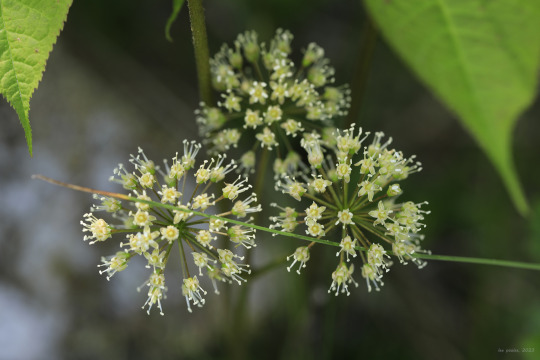
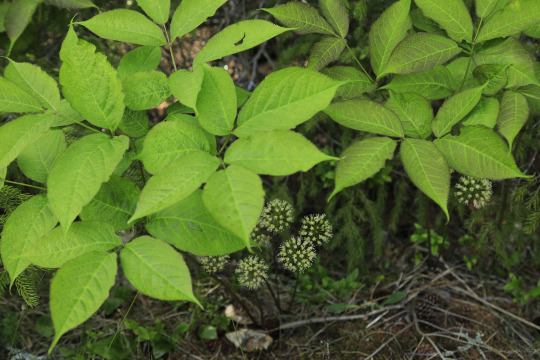
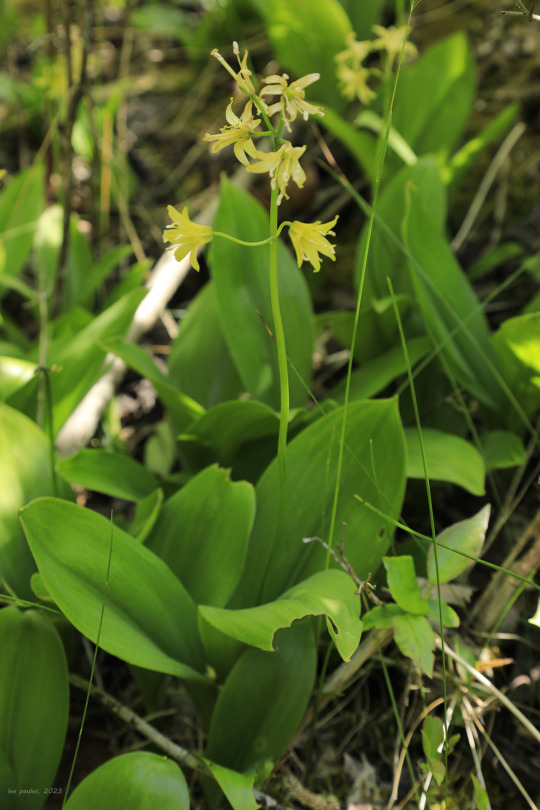
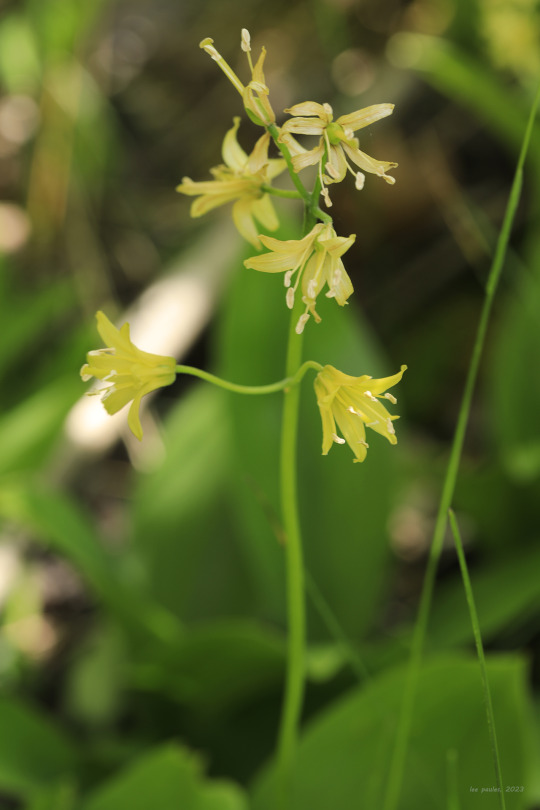
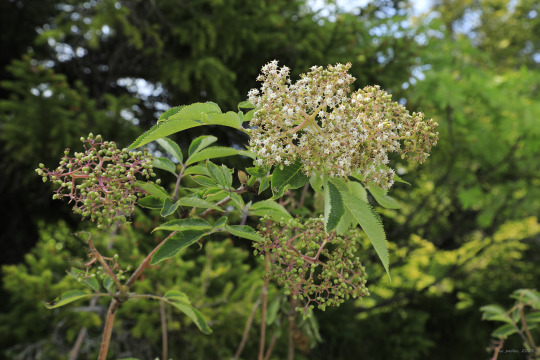
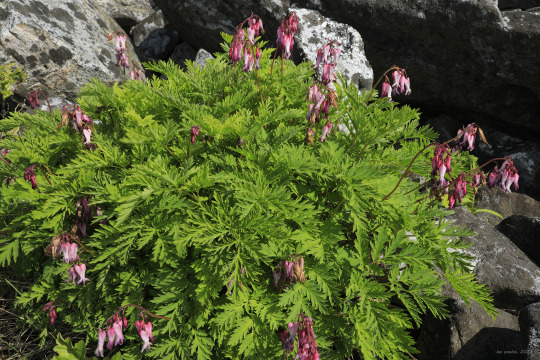



Day Date at Spruce Knob-Seneca Rocks National Recreation Area, Part 2. Gorgeous late spring day on the summit of Spruce Knob.
From top: View from the main overlook toward North Fork Mountain; flagged red spruce and broken Pottsville sandstone on the western-facing slope of the mountain; a close-up of a bunchberry (Cornus canadensis) "flower", characterized by four white bracts surrounding a mound of true, white to purplish flowers that will soon be replaced by edible, bright red berries; the ball-shaped, greenish-white flowers of wild sarsaparilla (Aralia nudicaulis), which cluster under the plant's umbrella-like leaves; the elegant yellow flower stalk of yellow Clintonia (Clintonia borealis), also known as bluebead lily for the porcelain blue berries that follow the flowers in late summer; a late-flowering red elderberry (Sambucus racemosa var. racemosa), also known as red-berried elder and scarlet elder, typically one of the first plants to bloom in Appalachia's higher elevations; fringed bleeding heart (Dicentra eximia), also known as turkey corn, a gorgeous perennial wildflower of Appalachia's higher mountains, much loved for its extended bloom time from spring through fall; and early azalea (Rhododendron prinophyllum), also known as roseshell azalea, a tall, hardy shrub that loves the acidic soil of the Appalachian highlands.
#appalachia#vandalia#west virginia#wildflowers#spring#flora#allegheny mountains#monongahela national forest#spruce knob#spruce mountain#bunchberry#canadian dwarf cornel#creeping dogwood#wild sarsaparilla#false sarsaparilla#yellow clintonia#bluebead lily#red elderberry#red-berried elder#scarlet elder#fringed bleeding heart#turkey corn#early azalea#roseshell azalea
35 notes
·
View notes
Photo


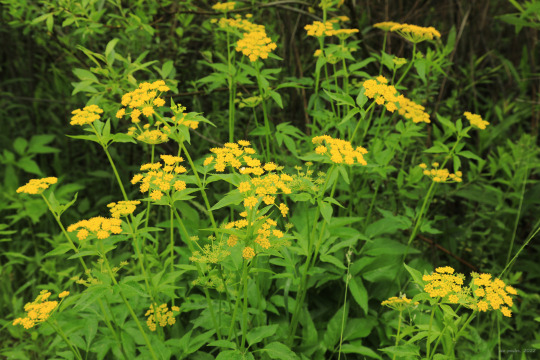


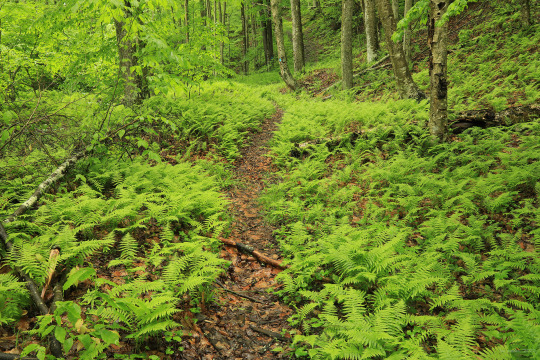



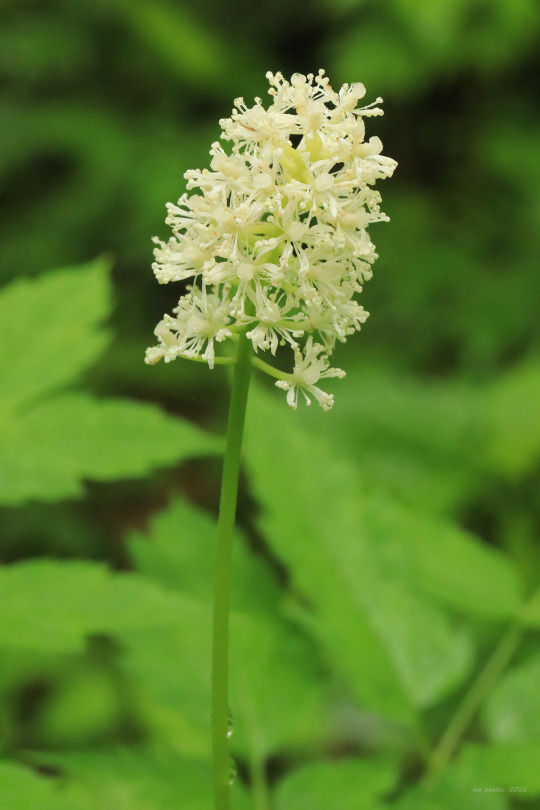
Gandy Creek and the Seneca Creek Backcountry together serve as the western gateways to the Spruce Knob-Seneca Rocks National Recreation Area in the Monongahela National Forest. This incredibly beautiful and wild area boasts one of the premier trail systems in the Mid-Atlantic region, with some 60 miles of trails winding through twenty-thousand acres of wilderness-quality red spruce and northern hardwood forests. Gandy and Seneca Creeks are also two of the most highly regarded brook trout streams in the eastern US. On Saturday, in a cool, clinging mist, I took a hike on one of the less traveled trails, the Leading Ridge Trail. The pulsating intensity of the new spring greens made them seem to glow in the dripping moisture.
From top: golden alexanders (Zizia aurea), the flagship spring wildflower of the mountains with its massed, golden flowerheads; Robin’s plantain (Erigeron pulchellus), a daisy-like spring aster with wide, lavender ray petals; brook lettuce (Micranthes micranthidifolia), whose edible leaves were once gathered in the spring by mountain folk for salads; and white baneberry (Actaea pachypoda), also known as doll’s eyes, because its white fruit in the fall resembles the china eyes once used in dolls.
#appalachia#vandalia#west virginia#monongahela national forest#seneca creek backcountry#gandy creek#leading ridge trail#allegheny mountains#zizia aurea#golden alexanders#erigeron pulchellus#robin's plantain#micranthes micranthidifolia#brook lettuce#deer tongue#mountain lettuce#branch lettuce#actaea pachypoda#white baneberry#doll's eyes
133 notes
·
View notes
Photo


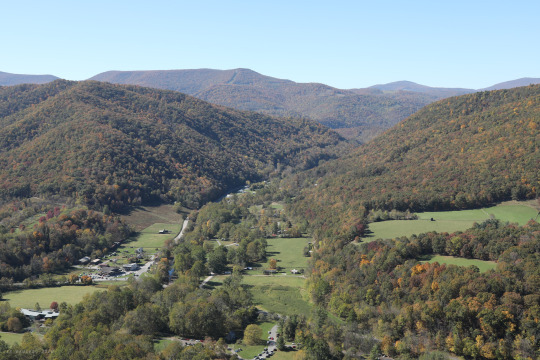

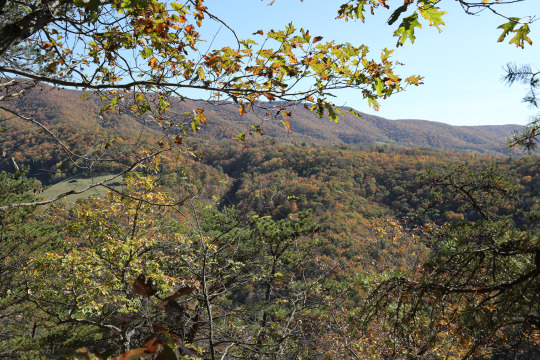


With sheer rock walls rising 900 feet above the North Fork of the South Branch of the Potomac River, Seneca Rocks is one of the premier rock-climbing destinations in the eastern United States and was a training site for the US Army’s 10th Alpine Division prior to its deployment to the Apennines Campaign in Italy during World War II. Formed of Tuscarora quartz sandstone thrust up from the earth more than 200 million years ago, it forms an imposing crag cradled between the Allegheny Mountains to the west and Northfork Mountain to the east. Although most of the razorback “fins” along the summit are only accessible to experienced rock climbers, a very steep and windy trail leads to an overlook near the northern-most fin, where the views east and west are quite breathtaking. Incidentally, the mountains to the east of the Allegheny Front are among the driest and most fire-prone in the eastern US, a fact reflected by the local ecology. The top of Seneca Rocks is dominated by Central Appalachian pine-oak rocky woodland, primarily consisting of elfin scrub oak and various pines, including Virginia, table mountain, and pitch pines.
#appalachia#vandalia#west virginia#seneca rocks#spruce knob-seneca rocks national recreation area#monongahela national forest#allegheny mountains#north fork mountain#crag#rock climbing#geology#tuscarora sandstone#quartzite#fall#autumn#leaf color#fire ecology
105 notes
·
View notes
Photo

Looking northwest from a high crag on Seneca Rocks toward Mt Porte Crayon and Dolly Sods on the Allegheny Front.
#appalachia#vandalia#west virginia#seneca rocks#spruce knob-seneca rocks national recreation area#monongahela national forest#allegheny mountains#mount porte crayon#dolly sods#allegheny front#fall#autumn#mountains#leaf color
33 notes
·
View notes
Photo

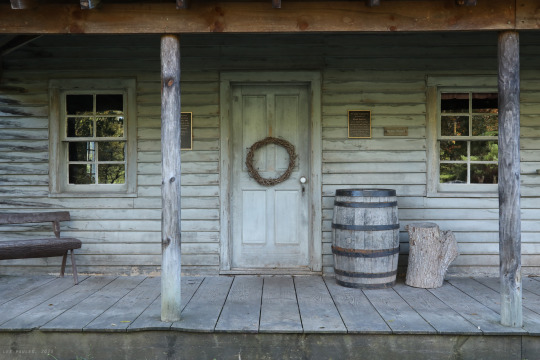

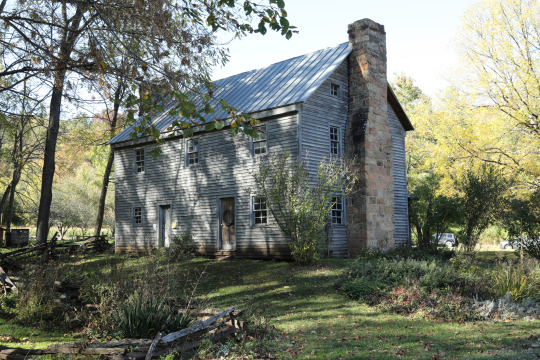
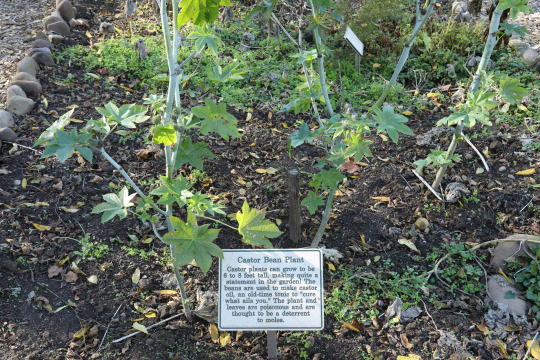

Jacob Sites broke ground on his pioneer homestead in 1839 in the shadow of Seneca Rocks’ towering sandstone cliffs. The home was initially constructed as a modest Blockbau-style log cabin, but it was later expanded into a Southern-style home with a Tudor stone fireplace and an expansive sun porch, which suited its transformation into a roadside inn. When the National Forest Service acquired the property as part of the Spruce Knob-Seneca Rocks National Recreation Area in the late 1960′s, the structure was severely run-down and in need of repairs. The Sites Homestead was subsequently restored to its full glory and opened to the public (although it is currently closed due to COVID-19). The family garden offers a fascinating sampling of the vegetables and herbs (including heirloom varieties) grown by early settlers in this area.
#appalachia#vandalia#west virginia#historical sites#homestead#human history#jacob sites#sites homestead#spruce knob-seneca rocks national recreation area#monongahela national forest#seneca rocks#sites inn#wayside inn
20 notes
·
View notes